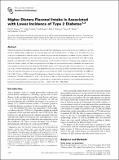Higher Dietary Flavonol Intake Is Associated with Lower Incidence of Type 2 Diabetes12

View/
Author
Jacques, Paul F.
Cassidy, Aedin
Rogers, Gail
Peterson, Julia J.
Dwyer, Johanna T.
Published Version
https://doi.org/10.3945/jn.113.177212Metadata
Show full item recordCitation
Jacques, Paul F., Aedin Cassidy, Gail Rogers, Julia J. Peterson, James B. Meigs, and Johanna T. Dwyer. 2013. “Higher Dietary Flavonol Intake Is Associated with Lower Incidence of Type 2 Diabetes12.” The Journal of Nutrition 143 (9): 1474-1480. doi:10.3945/jn.113.177212. http://dx.doi.org/10.3945/jn.113.177212.Abstract
Substantial experimental evidence suggests that several flavonoid classes are involved in glucose metabolism, but few clinical or epidemiologic studies exist that provide supporting human evidence for this relationship. The objective of this study was to determine if habitual intakes of specific flavonoid classes are related to incidence of type 2 diabetes (T2D). We followed 2915 members of the Framingham Offspring cohort who were free of T2D at baseline from 1991 to 2008. Diabetes was defined by either elevated fasting glucose (≥7.0 mmol/L) or initiation of hypoglycemic medication during follow-up. Dietary intakes of 6 flavonoid classes and total flavonoids were assessed using a validated, semiquantitative food frequency questionnaire. We observed 308 incident cases of T2D during a mean follow-up period of 11.9 y (range 2.5–16.8 y). After multivariable adjusted, time-dependent analyses, which accounted for long-term flavonoid intake during follow-up, each 2.5-fold increase in flavonol intake was associated with a 26% lower incidence of T2D [HR = 0.74 (95% CI: 0.61, 0.90); P-trend = 0.003] and each 2.5-fold increase in flavan-3-ol intake was marginally associated with an 11% lower incidence of T2D [HR = 0.89 (95% CI: 0.80, 1.00); P-trend = 0.06]. No other associations between flavonoid classes and risk of T2D were observed. Our observations support previous experimental evidence of a possible beneficial relationship between increased flavonol intake and risk of T2D.Other Sources
http://www.ncbi.nlm.nih.gov/pmc/articles/PMC3743276/pdf/Terms of Use
This article is made available under the terms and conditions applicable to Other Posted Material, as set forth at http://nrs.harvard.edu/urn-3:HUL.InstRepos:dash.current.terms-of-use#LAACitable link to this page
http://nrs.harvard.edu/urn-3:HUL.InstRepos:11855834
Collections
- HMS Scholarly Articles [17922]
Contact administrator regarding this item (to report mistakes or request changes)


